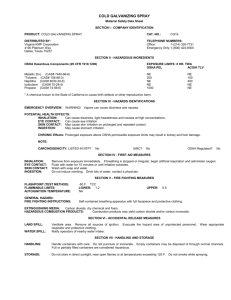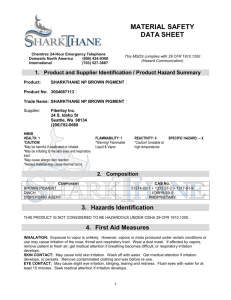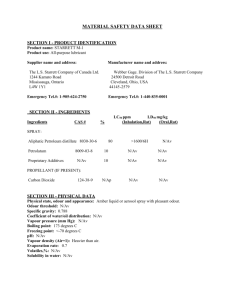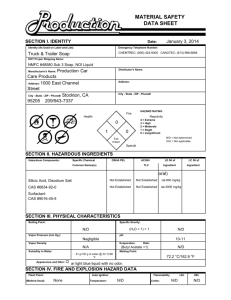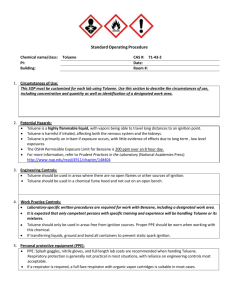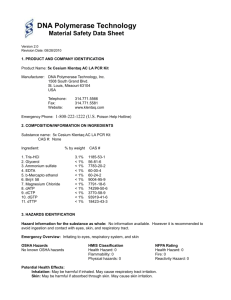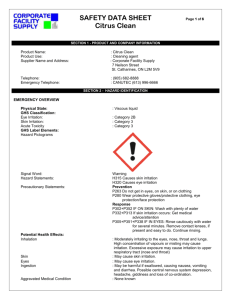CC20-C 475285 - Sporlan Online
advertisement
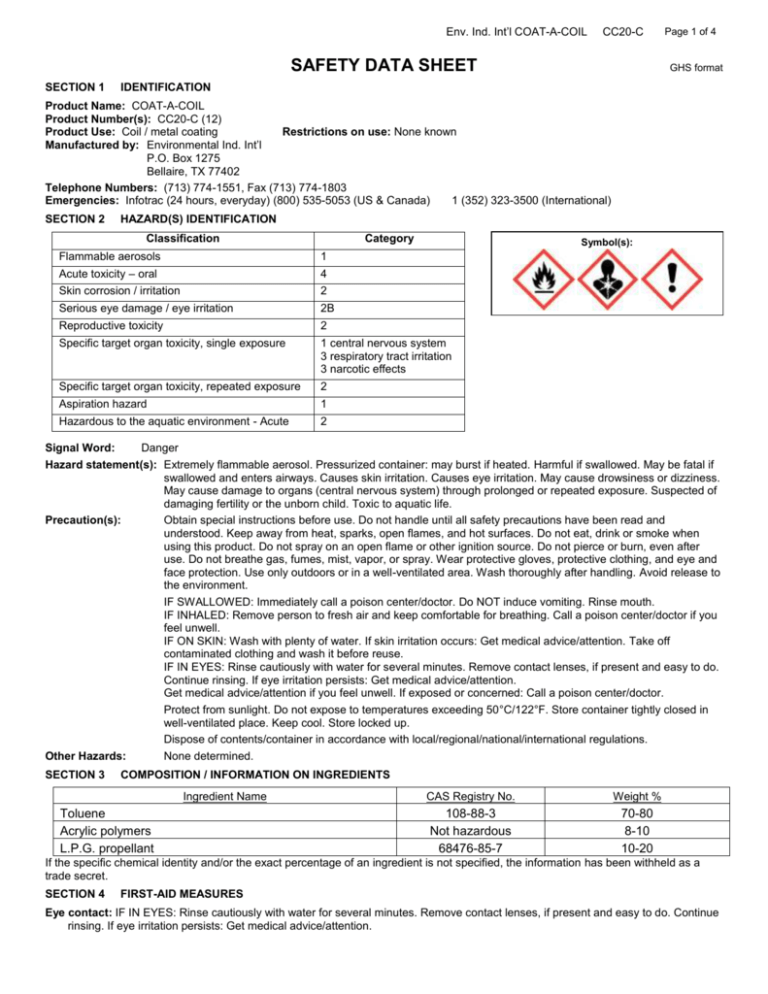
Env. Ind. Int’l COAT-A-COIL CC20-C SAFETY DATA SHEET SECTION 1 Page 1 of 4 GHS format IDENTIFICATION Product Name: COAT-A-COIL Product Number(s): CC20-C (12) Product Use: Coil / metal coating Restrictions on use: None known Manufactured by: Environmental Ind. Int’l P.O. Box 1275 Bellaire, TX 77402 Telephone Numbers: (713) 774-1551, Fax (713) 774-1803 Emergencies: Infotrac (24 hours, everyday) (800) 535-5053 (US & Canada) 1 (352) 323-3500 (International) SECTION 2 HAZARD(S) IDENTIFICATION Classification Category Symbol(s): Flammable aerosols 1 Acute toxicity – oral 4 Skin corrosion / irritation 2 Serious eye damage / eye irritation 2B Reproductive toxicity 2 Specific target organ toxicity, single exposure 1 central nervous system 3 respiratory tract irritation 3 narcotic effects Specific target organ toxicity, repeated exposure 2 Aspiration hazard 1 Hazardous to the aquatic environment - Acute 2 Signal Word: Danger Hazard statement(s): Extremely flammable aerosol. Pressurized container: may burst if heated. Harmful if swallowed. May be fatal if swallowed and enters airways. Causes skin irritation. Causes eye irritation. May cause drowsiness or dizziness. May cause damage to organs (central nervous system) through prolonged or repeated exposure. Suspected of damaging fertility or the unborn child. Toxic to aquatic life. Precaution(s): Obtain special instructions before use. Do not handle until all safety precautions have been read and understood. Keep away from heat, sparks, open flames, and hot surfaces. Do not eat, drink or smoke when using this product. Do not spray on an open flame or other ignition source. Do not pierce or burn, even after use. Do not breathe gas, fumes, mist, vapor, or spray. Wear protective gloves, protective clothing, and eye and face protection. Use only outdoors or in a well-ventilated area. Wash thoroughly after handling. Avoid release to the environment. IF SWALLOWED: Immediately call a poison center/doctor. Do NOT induce vomiting. Rinse mouth. IF INHALED: Remove person to fresh air and keep comfortable for breathing. Call a poison center/doctor if you feel unwell. IF ON SKIN: Wash with plenty of water. If skin irritation occurs: Get medical advice/attention. Take off contaminated clothing and wash it before reuse. IF IN EYES: Rinse cautiously with water for several minutes. Remove contact lenses, if present and easy to do. Continue rinsing. If eye irritation persists: Get medical advice/attention. Get medical advice/attention if you feel unwell. If exposed or concerned: Call a poison center/doctor. Protect from sunlight. Do not expose to temperatures exceeding 50°C/122°F. Store container tightly closed in well-ventilated place. Keep cool. Store locked up. Dispose of contents/container in accordance with local/regional/national/international regulations. Other Hazards: None determined. SECTION 3 COMPOSITION / INFORMATION ON INGREDIENTS Ingredient Name Toluene Acrylic polymers L.P.G. propellant CAS Registry No. Weight % 108-88-3 Not hazardous 68476-85-7 70-80 8-10 10-20 If the specific chemical identity and/or the exact percentage of an ingredient is not specified, the information has been withheld as a trade secret. SECTION 4 FIRST-AID MEASURES Eye contact: IF IN EYES: Rinse cautiously with water for several minutes. Remove contact lenses, if present and easy to do. Continue rinsing. If eye irritation persists: Get medical advice/attention. Env. Ind. Int’l COAT-A-COIL CC20-C Page 2 of 4 Inhalation: IF INHALED: Remove person to fresh air and keep comfortable for breathing. Call a POISON CENTER/doctor if you feel unwell. Skin contact: IF ON SKIN: Wash with plenty of water. If skin irritation occurs: Get medical advice/attention. Take off contaminated clothing and wash it before reuse. Ingestion: IF SWALLOWED: Immediately call a poison center/doctor. Do NOT induce vomiting. Rinse mouth. Most important symptoms/effects: Irritation. Drowsiness and dizziness. Prolonged exposure may cause chronic effects. Indication of immediate medical attention and special treatment needed, if necessary: Notes to physician: Treat symptomatically. Specific treatments: Show this safety data sheet to the doctor in attendance. SECTION 5 FIRE-FIGHTING MEASURES Suitable (and unsuitable) extinguishing media: Water spray. Water fog. Foam. Dry chemical powder. Carbon dioxide (CO2). Do not use a solid water stream as it may scatter and spread fire. Specific hazards arising from the chemical: Vapor may cause flash fire. Vapors can flow along surfaces to distant ignition source and flash back. Sensitive to static discharge. Special protective equipment for fire-fighters: Use appropriate equipment for surrounding fire. SECTION 6 ACCIDENTAL RELEASE MEASURES Personal precaution, protective equipment and emergency procedures: Keep unnecessary personnel away. ELIMINATE all ignition sources (no smoking, flares, sparks or flames in immediate area). Extinguish all flames in the vicinity. Keep combustibles (wood, paper, oil, etc.) away from spilled material. Keep upwind. Keep out of low areas. Ventilate closed spaces before entering. Do not touch damaged containers or spilled material unless wearing appropriate protective clothing. See Section 8 of the SDS for Personal Protective Equipment. Methods and materials for containment and cleaning-up: Large Spills: Stop the flow of material, if this is without risk. Dike the spilled material, where this is possible. Small Spills: Use a non-combustible material like vermiculite, sand or earth to soak up the product and place into a container for later disposal. Cover with plastic sheet to prevent spreading. Collect spillage. Following product recovery, flush area with water. Prevent product from entering drains. Do not allow material to contaminate ground water system. Clean surface thoroughly to remove residual contamination. Wipe up with absorbent material (e.g. cloth, fleece). Prevent entry into waterways, sewers, basements or confined areas. Stop leak if you can do so without risk. This material is a water pollutant and should be prevented from contaminating soil or from entering sewage and drainage systems and bodies of water. Dike the spilled material, where this is possible. Eliminate all ignition sources (no smoking, flares, sparks, or flames in immediate area). Absorb spill with vermiculite or other inert material, then place in a container for chemical waste. Clean surface thoroughly to remove residual contamination. Should not be released into the environment. Do not allow material to contaminate ground water system. Prevent product from entering drains. SECTION 7 HANDLING AND STORAGE Precautions for safe handling: Eliminate sources of ignition. Avoid spark promoters. Wear personal protective equipment. Do not breathe gas/fumes/vapor/spray. Avoid contact with eyes, skin, and clothing. Do not taste or swallow. Avoid prolonged exposure. Use only with adequate ventilation. Wash thoroughly after handling. The product is extremely flammable, and explosive vapor/air mixtures may be formed even at normal room temperatures. DO NOT handle, store or open near an open flame, sources of heat or sources of ignition. Protect material from direct sunlight. Take precautionary measures against static discharges. All equipment used when handling the product must be grounded. Use non-sparking tools and explosion-proof equipment. When using, do not eat, drink or smoke. Avoid release to the environment. Conditions for safe storage, including any incompatibilities: KEEP OUT OF REACH OF CHILDREN. Store locked up. Keep tightly closed in original container. Flammable liquid storage. Do not handle or store near an open flame, heat or other sources of ignition. This material can accumulate static charge which may cause spark and become an ignition source. Keep container tightly closed in a cool, well-ventilated place. Keep away from food, drink and animal feedingstuffs. SECTION 8 EXPOSURE CONTROLS / PERSONAL PROTECTION Chemical name Toluene CAS 108-88-3 OSHA PEL ACGIH TLV NIOSH REL TWA: 200 ppm TWA: 20 ppm TWA: 375 mg/m³ 100 ppm Ceiling: 300 ppm STEL: 560 mg/m3 150 ppm Appropriate engineering controls: Provide adequate general and local exhaust ventilation. Use process enclosures, local exhaust ventilation, or other engineering controls to control airborne levels below recommended exposure limits. Use explosion-proof equipment. Individual protection measures (PPE): Consult supervisor for special handling instructions. Avoid contact with eyes. Avoid contact with skin. Keep away from food and drink. Wash hands before breaks and immediately after handling the product. Provide eyewash station and safety shower. Handle in accordance with good industrial hygiene and safety practice. Eye protection: Chemical Wear safety glasses. If splash potential exists, wear full face shield or chemical goggles. Hand protection: Wear suitable protective gloves. Env. Ind. Int’l COAT-A-COIL CC20-C Page 3 of 4 Skin and body protection: If major exposure is possible, wear suitable protective clothing and footwear. Respiratory Protection: In case of insufficient ventilation, wear suitable respiratory equipment. A respiratory protection program that meets OSHA’s 29 CFR 1910.134 and ANSI Z88.2 requirements must be implemented whenever workplace conditions warrant use of a respirator. SECTION 9 PHYSICAL AND CHEMICAL PROPERTIES Appearance Blue liquid U/L flammability or explosive limits Flam L – 1.2% Flam U – 7.1% Odor Sweet / Pungent Vapor pressure Not determined Odor threshold Not determined Vapor density 3.14 pH Not applicable Relative density (specific gravity) Not determined Melting point/freezing point 42°F (5.56°C) Solubility(ies) Very slightly soluble Initial boiling point and boiling range 230°F (110°C) Partition coefficient: n-octanol/water Not determined Flash point 40°F (4.8°C) closed cup Auto-ignition temperature 996°F (535°C) Evaporation rate 2 (n-butyl acetate = 1) Decomposition temperature Not determined Flammability (solid, gas) Not determined Viscosity Not determined SECTION 10 STABILITY AND REACTIVITY Reactivity: Stable under normal conditions. Chemical stability: Stable under normal temperature conditions and recommended use. Possibility of hazardous reactions: Hazardous polymerization does not occur. Conditions to Avoid: Heat, flames and sparks. Ignition sources. Contact with incompatible materials. Do not pressurize, cut, weld, braze, solder, drill, grind or expose empty containers to heat, flame, sparks, static electricity, or other sources of ignition; they may explode and cause injury or death. Incompatible materials: Strong oxidizing agents. Reducing agents. Acids. Alkalis. Hazardous decomposition products: No hazardous decomposition products are known. SECTION 11 TOXICOLOGICAL INFORMATION Information on likely routes of exposure: Ingestion: Harmful if swallowed. May be fatal if swallowed and enters airways. Inhalation: May cause drowsiness or dizziness. May cause damage to organs (Central nervous system) through prolonged or repeated exposure. Eye contact: Causes eye irritation. Skin contact: Causes skin irritation. Symptoms related to the physical, chemical and toxicological characteristics: Irritation. Drowsiness and dizziness. May cause damage to organs (Central nervous system) through prolonged or repeated exposure. Numerical measure of toxicity, component information: Chemical name CAS Oral LD50 Dermal LD50 Inhalation LC50 Toluene 108-88-3 636 mg/kg (rat) 14.1 ml/kg (rabbit) 49,000 mg/m3, 4 hours Acute toxicity: Harmful if swallowed - may enter lungs if swallowed or vomited. Skin corrosion/irritation: Causes skin irritation. Serious eye damage/irritation: Causes eye irritation. Respiratory sensitization: Not assigned. Skin sensitization: Not assigned. Germ cell mutagenicity: Not assigned. Carcinogenicity: This material is not classified as a carcinogen by IARC, ACGIH, NTP or OSHA. IARC Monographs. Overall Evaluation of Carcinogenicity: Toluene (CAS 108-88-3): 3 Not classifiable as to carcinogenicity to humans. Reproductive Toxicity: May damage fertility or the unborn child. Avoid contact during pregnancy/while nursing. Toluene: May adversely affect the developing fetus. Specific target organ toxicity, single exposure: May cause drowsiness or dizziness. Specific target organ toxicity, repeated exposure: May cause damage to organs (central nervous system) through prolonged or repeated exposure. Chronic effects: Toluene has been reported to decrease immunological responses and cause recordable hearing loss in laboratory animals. Contains organic solvents which in case of overexposure may depress the central nervous system causing dizziness and intoxication. Env. Ind. Int’l COAT-A-COIL CC20-C Page 4 of 4 Further information: Abusive inhalation of toluene ("glue sniffing") has been reported to be associated with birth defects in the offspring of abusers. SECTION 12 ECOLOGICAL INFORMATION Ecotoxicity: No information available. Persistence and degradability: No information available. Bioaccumulation potential: No information available. Mobility in soil: No information available. Other adverse effects: None known. SECTION 13 DISPOSAL CONSIDERATIONS Unused product: This product, as sold, if discarded or disposed, is a hazardous waste according to federal regulations. Dispose of container and contents in accordance with local, regional, national and international regulations. Contaminated containers or packaging: Do not reuse empty containers. Dispose of packaging or containers in accordance with local, regional, national and international regulations. RCRA Hazard Class: D001 Flammable material with a flash point <140°F. U220: Waste toluene. SECTION 14 TRANSPORT INFORMATION Agency Proper Shipping Name DOT (ground), IMDG Aerosols, Limited Quantity IATA Not suitable for air shipment as packaged from factory SECTION 15 UN Number Packing Group Hazard Class UN1950 – 2.1 REGULATORY INFORMATION TSCA: All components of this product are on the U.S. Toxic Substances Control Act (TSCA) Chemical Substances Inventory or are exempt. CERCLA: Toluene (108-88-3); RQ 1000 lbs. SARA TITLE III: Section 311/312 Hazard Category: Acute: Yes Chronic: Yes Fire: Yes Sudden Release of Pressure: No Reactive Hazard: No Section 313 Reportable Ingredients: Toluene (108-88-3) CALIFORNIA (Proposition 65): WARNING: This product contains the following chemicals known to the State of California to cause cancer and birth defects or other reproductive harm: Toluene (108-88-3), Benzene (71-43-2). SECTION 16 OTHER INFORMATION Date Prepared: Apr. 03, 2015 Replaces: Apr. 03, 2014 NOTICE: This document has been prepared using data from sources considered technically reliable. It does not constitute a warranty, express or implied, as to accuracy of the information contained within. Actual conditions of use and handling are beyond seller’s control. User is responsible to evaluate all available information when using product for any particular use and to comply with all federal, state, provincial, and local laws and regulations. Vendor Provided for Vendor Labeled Product

